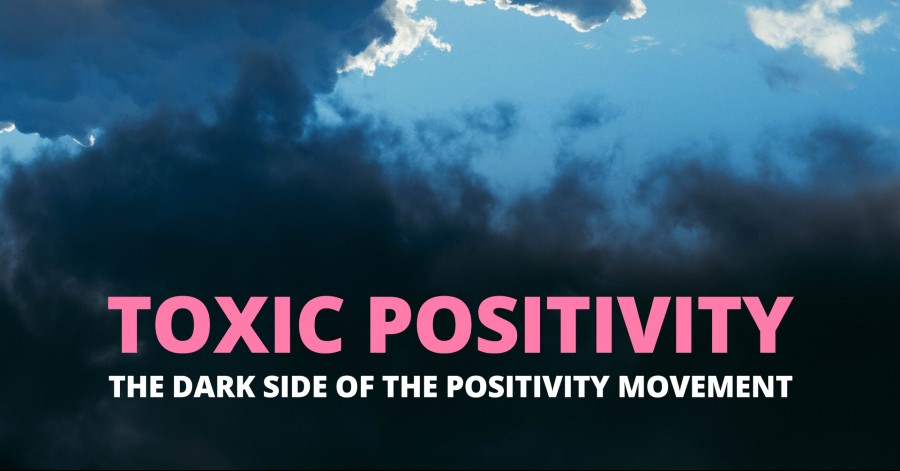
What is Toxic Positivity?
Toxic positivity is the excessive application of a happy, optimistic state during all situations. This can result in the denial and invalidation of our legitimate human emotions (1).
When positivity is used to cover up or mute how we really feel, it can become toxic. By refusing to acknowledge that certain feelings exist, we can end up in denial, with repressed emotions. The truth is not everything in our lives will be a positive experience. Sometimes bad things happen, and it’s ok not to be ok with that. By forcing ‘positive vibes only’, we are not allowing ourselves to process and deal with the emotions we are really feeling.
While friends may have the best of intentions with phrases like ‘look on the bright side’ or ‘be grateful for what you have’, you may actually end up feeling worse – and guilty for having the negative emotion in the first place (2)(3).
While it’s no bad thing to be someone who likes to focus on the positive, it’s important you also let yourself fully process the less positive emotions. By not dealing with these emotions properly, you are pushing them down. Ultimately, both your physical and mental health may suffer (4).
Toxic Positivity in a Pandemic
The COVID-19 pandemic appears to have been a tremendous trigger for the toxic positivity phenomenon. We are under attack from all sides (and mostly social media) with ideas about how we must use this time away from the office to write a novel, learn a language or find inner peace. If we fail to live up to these expectations, it’s as though we have somehow failed the pandemic. How does this make us feel? What about those of us who are struggling to even make it through the day, let alone achieving life-affirming feats?
If people are finding their zen and limitless silver linings, then hats off to them. But incessant promotion of this approach, however well-meaning, can become toxic. These kinds of messages can exacerbate the anxiety and devastation ripping through some of our lives right now. And they rob us of our right to have down days in the midst of the crisis.
It’s important to acknowledge that it’s perfectly natural to feel multiple, complex emotions all at once. You can be thankful your family have remained safe and well through the pandemic, but hate the fact that you have spent most of lockdown alone and are worried about the future. You can be devastated at the recent loss of life to the pandemic, but still enjoy how life has slowed down during lockdown.
Feelings of anxiety can in fact be protective at the moment. It motivates us to take precautions such as washing our hands, wearing a mask and practicing social distancing out of concern for getting ourselves or others unwell. Worry is a normal response to this very abnormal situation.
The main point is that COVID-19 has hit all of us in different ways, and there’s no right or wrong way to feel. If you have struggled, you don’t necessarily need others to feel the same. The same goes for those who have thrived. There’s nothing wrong with being positive, but if that need for positivity is overshadowing how you really feel, then it may not be good for you. All feelings should be processed.
How to Deal with Toxic Positivity
1. All emotions are allowed
Remember that holding multiple perspectives about uncertain or troubling situations is totally normal. Allow yourself to feel both the positive and the negative. Be grateful for what you do have, but also be honest and accept what’s bothering you. From missed celebrations to concerns about the future (5), it all matters.
2. Explore your emotions
Look at implementing strategies to help you examine your own anxieties and how to manage them. Try journaling in the morning, before bed or any time you’re feeling overwhelmed. One interesting study on the topic shows us that putting our feelings into words may help us process our emotions and reduce the intensity of feelings such as sadness, anger and pain (6). While another study explains that journaling is associated with a reduction in symptoms of anxiety and depression and with creating greater resilience (9).
By writing down our worries and anxieties, even if we can’t actively do anything about them, we’ve communicated with our brains that they’re being dealt with and it’s OK to let them go.
You can also try incorporating deep breathing techniques coupled with guided meditations that recognise the anxiety and acknowledge it in order to move forward.
3. Be realistic
If you feel like you are dealing with the difficult emotions you’re feeling and starting to feel like you want to be productive, try starting with small steps.
During times of emotional distress, it’s a good idea to expand on things you are already good at and familiar with. Avoid treading too far from what you know until you feel better.
If you enjoy pilates, try a different variation of that instead of a completely new exercise. Doing things that are extensions of your existing behavioural repertoire requires less mental effort and protects you from not meeting unrealistic expectations.
4. Learn to identify toxic positivity
What makes positivity toxic is that it nullifies other real emotions. If the message is that positivity is the only way to go without dealing with any other emotions, that can be problematic.
To help yourself or to support others, educate yourself on the difference between toxic positivity responses and responses that are genuinely supportive and validating.
| Toxic Positivity | Acceptance and Validation |
| ‘Ignore it, keep positive’ | ‘Tell me what you’re feeling; I’m here.’ |
| ‘Don’t worry about it’ | ‘I understand. Can I help?’ |
| ‘Failure is not an option’ | ‘Our biggest learnings come from our biggest failures.’ |
| ‘It could be worse’ | ‘That’s terrible. I’m so sorry you’re dealing with this.’ |
| ‘You should try not to be so negative’ | ‘That’s really hard. I hope things improve.’ |
5. Social media is not a safe place
Between filters, lighting and outright lies, what you see on social media is not always real. Rarely do people post their faults, down days or real-life mistakes. As a result, social media can make you feel like everyone is handling hard times better than you. This can make you feel alone, anxious, depressed or weaker than others (7)(8).
Watch out for social media influencers: many make a living by promoting toxic positivity by only posting their best outfits, workouts, holidays and what appears to be flawless lives.
Protecting yourself from social media requires critical thinking. Recognise that you’re not alone in your worries and lack of energy/motivation. This can help counteract the unrealistic expectations that are being promoted.
If you feel you’re being influenced by toxic positivity, or even if you’re the one who is – with the best of intentions – putting toxic positivity out there, try to be mindful going forward. Set healthy boundaries with anyone who passes judgment on your experience and don’t be afraid to speak your truth. Don’t be afraid to show people both your positive and negative experiences and remember if someone is struggling to understand and support them without minimising their experience. We get one chance at life… embrace it completely and you’ll reap the rewards of a full and real life.
References:
1. Holahan, C.J., Moos, R.H., Holahan, C.K., Brennan, P.L. and Schutte, K.K. (2005). Stress Generation, Avoidance Coping, and Depressive Symptoms: A 10-Year Model. Journal of Consulting and Clinical Psychology, [online] 73(4), pp.658–666. Available at: https://pubmed.ncbi.nlm.nih.gov/16173853/ [Accessed 18 Sep. 2020]
2. B, B., P, K., Mj, H., J, P., P, K. and Y, U. (2012). Feeling bad about being sad: the role of social expectancies in amplifying negative mood. [online] Emotion (Washington, D.C.). Available at: https://pubmed.ncbi.nlm.nih.gov/21787076/ [Accessed 18 Sep. 2020]
3. Wood, J.V., Elaine Perunovic, W.Q. and Lee, J.W. (2009). Positive Self-Statements. Psychological Science, [online] 20(7), pp.860–866. Available at: https://journals.sagepub.com/doi/abs/10.1111/j.1467-9280.2009.02370.x [Accessed 16 Sep. 2020]
4. Gross, J.J. and Levenson, R.W. (1997). Hiding feelings: The acute effects of inhibiting negative and positive emotion. Journal of Abnormal Psychology, [online] 106(1), pp.95–103. Available at: https://pdfs.semanticscholar.org/f2b1/d2302bc3d69695823dbaec3b49bf30747244.pdf [Accessed 18 Sep. 2020]
5. Oettingen, G., Mayer, D. and Portnow, S. (2016). Pleasure Now, Pain Later. Psychological Science, [online) 27(3), pp.345–353. Available at: https://journals.sagepub.com/doi/abs/10.1177/0956797615620783?papetoc [Accessed 16 Sep. 2020]
6. Lieberman, M., Eisenberger, N., Crockett, M., Tom, S., Pfeifer, J. and Way, B. (n.d.). Putting Feelings Into Words Affect Labeling Disrupts Amygdala Activity in Response to Affective Stimuli. [online] Available at: https://www.scn.ucla.edu/pdf/AL(2007).pdf. [Accessed 17 Sep. 2020]
7. Karim, F., Oyewande, A., Abdalla, L.F., Chaudhry Ehsanullah, R. and Khan, S. (2020). Social Media Use and Its Connection to Mental Health: A Systematic Review. Cureus. [online]. Available at: https://pmc.ncbi.nlm.nih.gov/articles/PMC7364393/ [Accessed 16 Sep. 2020]
8. Berry, N., Emsley, R., Lobban, F. and Bucci, S. (2018). Social media and its relationship with mood, self-esteem and paranoia in psychosis. Acta Psychiatrica Scandinavica, [online] 138(6), pp.558–570. Available at: https://pmc.ncbi.nlm.nih.gov/articles/PMC6221086/ [Accessed 18 Sep. 2020]
9. Smyth, J.M., Johnson, J.A., Auer, B.J., Lehman, E., Talamo, G. and Sciamanna, C.N. (2018). Online Positive Affect Journaling in the Improvement of Mental Distress and Well-Being in General Medical Patients With Elevated Anxiety Symptoms: A Preliminary Randomized Controlled Trial. JMIR Mental Health, [online] 5(4), p.e11290. Available at: https://pmc.ncbi.nlm.nih.gov/articles/PMC6305886/ [Accessed 18 Sep. 2020]


